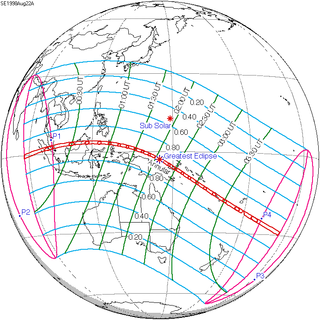
An annular solar eclipse occurred at the Moon’s ascending node of orbit on Saturday, August 22, 1998, with a magnitude of 0.9734. A solar eclipse occurs when the Moon passes between Earth and the Sun, thereby totally or partly obscuring the image of the Sun for a viewer on Earth. An annular solar eclipse occurs when the Moon's apparent diameter is smaller than the Sun's, blocking most of the Sun's light and causing the Sun to look like an annulus (ring). An annular eclipse appears as a partial eclipse over a region of the Earth thousands of kilometres wide. Annularity was visible in Indonesia, Malaysia, Papua New Guinea, Solomon Islands and Vanuatu. Occurring only 5.2 days before apogee, the Moon’s apparent diameter was 3.6% smaller than average.
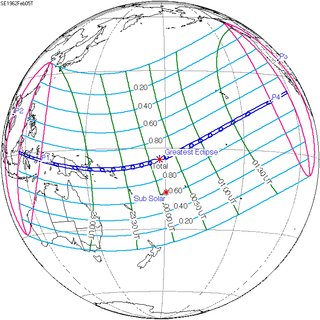
A total solar eclipse occurred at the Moon's descending node of orbit on Monday, February 5, 1962, with a magnitude of 1.043. A solar eclipse occurs when the Moon passes between Earth and the Sun, thereby totally or partly obscuring the image of the Sun for a viewer on Earth. A total solar eclipse occurs when the Moon's apparent diameter is larger than the Sun's, blocking all direct sunlight, turning day into darkness. Totality occurs in a narrow path across Earth's surface, with the partial solar eclipse visible over a surrounding region thousands of kilometres wide. Totality was visible from Indonesia, Netherlands New Guinea, the Territory of Papua New Guinea, British Solomon Islands, and Palmyra Atoll.

An annular solar eclipse occurred at the Moon's descending node of orbit on Sunday, December 4, 1983, with a magnitude of 0.9666. A solar eclipse occurs when the Moon passes between Earth and the Sun, thereby totally or partly obscuring the image of the Sun for a viewer on Earth. An annular solar eclipse occurs when the Moon's apparent diameter is smaller than the Sun's, blocking most of the Sun's light and causing the Sun to look like an annulus (ring). An annular eclipse appears as a partial eclipse over a region of the Earth thousands of kilometres wide. Annularity was visible in Cape Verde, Annobón Island of Equatorial Guinea, Gabon, the People's Republic of Congo, Zaire, northern Uganda, southern Sudan, northwestern Kenya, Ethiopia and Somalia. The Sun's altitude was 66°. Occurring 6.5 days before apogee, the Moon's apparent diameter was near the average diameter.

A total solar eclipse will occur at the Moon's descending node of orbit on Friday, August 24, 2063, with a magnitude of 1.075. A solar eclipse occurs when the Moon passes between Earth and the Sun, thereby totally or partly obscuring the image of the Sun for a viewer on Earth. A total solar eclipse occurs when the Moon's apparent diameter is larger than the Sun's, blocking all direct sunlight, turning day into darkness. Totality occurs in a narrow path across Earth's surface, with the partial solar eclipse visible over a surrounding region thousands of kilometres wide.
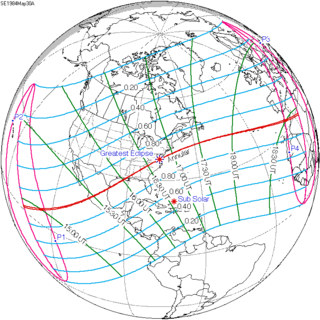
An annular solar eclipse occurred at the Moon's ascending node of orbit on Wednesday, May 30, 1984, with a magnitude of 0.998. A solar eclipse occurs when the Moon passes between Earth and the Sun, thereby totally or partly obscuring the image of the Sun for a viewer on Earth. An annular solar eclipse occurs when the Moon's apparent diameter is smaller than the Sun's, blocking most of the Sun's light and causing the Sun to look like an annulus (ring). An annular eclipse appears as a partial eclipse over a region of the Earth thousands of kilometres wide. Annularity was visible in Mexico, the United States, Azores Islands, Morocco and Algeria. It was the first annular solar eclipse visible in the US in 33 years. The Moon's apparent diameter was near the average diameter because it occurred 6.7 days after apogee and 7.8 days before perigee.
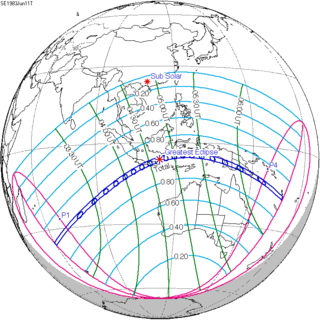
A total solar eclipse occurred at the Moon's ascending node of orbit on Saturday, June 11, 1983, with a magnitude of 1.0524. A solar eclipse occurs when the Moon passes between Earth and the Sun, thereby totally or partly obscuring the image of the Sun for a viewer on Earth. A total solar eclipse occurs when the Moon's apparent diameter is larger than the Sun's, blocking all direct sunlight, turning day into darkness. Totality occurs in a narrow path across Earth's surface, with the partial solar eclipse visible over a surrounding region thousands of kilometres wide. Occurring only 48 hours before perigee, the Moon's apparent diameter was larger.
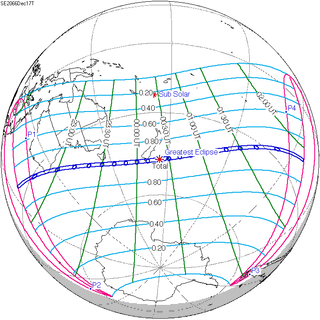
A total solar eclipse will occur at the Moon's ascending node of orbit on Friday, December 17, 2066, with a magnitude of 1.0416. A solar eclipse occurs when the Moon passes between Earth and the Sun, thereby totally or partly obscuring the image of the Sun for a viewer on Earth. A total solar eclipse occurs when the Moon's apparent diameter is larger than the Sun's, blocking all direct sunlight, turning day into darkness. Totality occurs in a narrow path across Earth's surface, with the partial solar eclipse visible over a surrounding region thousands of kilometres wide.

An annular solar eclipse occurred at the Moon's ascending node of orbit on Sunday, August 10, 1980, with a magnitude of 0.9727. A solar eclipse occurs when the Moon passes between Earth and the Sun, thereby totally or partly obscuring the image of the Sun for a viewer on Earth. An annular solar eclipse occurs when the Moon's apparent diameter is smaller than the Sun's, blocking most of the Sun's light and causing the Sun to look like an annulus (ring). An annular eclipse appears as a partial eclipse over a region of the Earth thousands of kilometres wide. Annularity was visible in Tabuaeran of Kiribati, Peru, Bolivia, northern Paraguay and Brazil. Occurring 5 days before apogee, the Moon's apparent diameter was smaller. At greatest eclipse, the Sun was 79 degrees above horizon.
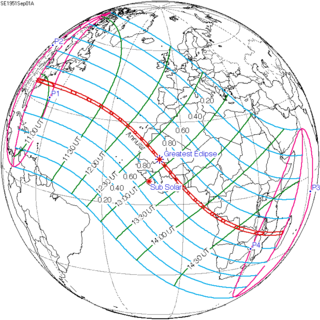
An annular solar eclipse occurred at the Moon's descending node of orbit on Saturday, September 1, 1951, with a magnitude of 0.9747. A solar eclipse occurs when the Moon passes between Earth and the Sun, thereby totally or partly obscuring the image of the Sun for a viewer on Earth. An annular solar eclipse occurs when the Moon's apparent diameter is smaller than the Sun's, blocking most of the Sun's light and causing the Sun to look like an annulus (ring). An annular eclipse appears as a partial eclipse over a region of the Earth thousands of kilometres wide. Annularity was visible from the United States, Spanish Sahara, French West Africa, British Gold Coast, southern tip of French Equatorial Africa, Belgian Congo, Northern Rhodesia, Portuguese Mozambique, Nyasaland, and French Madagascar.

A total solar eclipse occurred at the Moon's ascending node of orbit on Thursday, May 9, 1929, with a magnitude of 1.0562. A solar eclipse occurs when the Moon passes between Earth and the Sun, thereby totally or partly obscuring the image of the Sun for a viewer on Earth. A total solar eclipse occurs when the Moon's apparent diameter is larger than the Sun's, blocking all direct sunlight, turning day into darkness. Totality occurs in a narrow path across Earth's surface, with the partial solar eclipse visible over a surrounding region thousands of kilometres wide. Totality was visible from Dutch East Indies, Federated Malay States, Siam, French Indochina, Spratly Islands, Philippines, and South Seas Mandate in Japan.

An annular solar eclipse will occur at the Moon's ascending node of orbit on Sunday, September 22, 2052, with a magnitude of 0.9734. A solar eclipse occurs when the Moon passes between Earth and the Sun, thereby totally or partly obscuring the image of the Sun for a viewer on Earth. An annular solar eclipse occurs when the Moon's apparent diameter is smaller than the Sun's, blocking most of the Sun's light and causing the Sun to look like an annulus (ring). An annular eclipse appears as a partial eclipse over a region of the Earth thousands of kilometres wide.
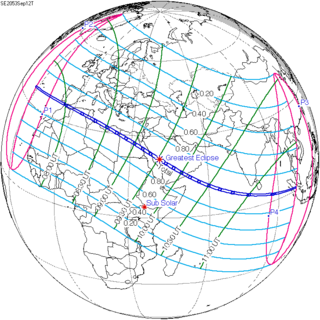
A total solar eclipse will take place at the Moon's ascending node of orbit on Friday, September 12, 2053, with a magnitude of 1.0328. A solar eclipse occurs when the Moon passes between Earth and the Sun, thereby totally or partly obscuring the image of the Sun for a viewer on Earth. A total solar eclipse occurs when the Moon's apparent diameter is larger than the Sun's, blocking all direct sunlight, turning day into darkness. Totality occurs in a narrow path across Earth's surface, with the partial solar eclipse visible over a surrounding region thousands of kilometres wide.

An annular solar eclipse will occur at the Moon's descending node of orbit on Saturday, June 11, 2067, with a magnitude of 0.967. A solar eclipse occurs when the Moon passes between Earth and the Sun, thereby totally or partly obscuring the image of the Sun for a viewer on Earth. An annular solar eclipse occurs when the Moon's apparent diameter is smaller than the Sun's, blocking most of the Sun's light and causing the Sun to look like an annulus (ring). An annular eclipse appears as a partial eclipse over a region of the Earth thousands of kilometres wide.
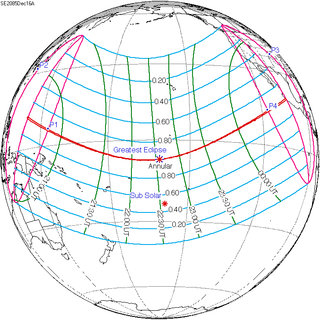
An annular solar eclipse will occur at the Moon's ascending node of orbit on Sunday, December 16, 2085, with a magnitude of 0.9971. A solar eclipse occurs when the Moon passes between Earth and the Sun, thereby totally or partly obscuring the image of the Sun for a viewer on Earth. An annular solar eclipse occurs when the Moon's apparent diameter is smaller than the Sun's, blocking most of the Sun's light and causing the Sun to look like an annulus (ring). An annular eclipse appears as a partial eclipse over a region of the Earth thousands of kilometres wide. If a moon with same apparent diameter in this eclipse near the Aphelion, it will be Total Solar Eclipse, but in this time of the year, just 2 weeks and 4 days before perihelion, it is an Annular Solar Eclipse.

An annular solar eclipse will occur at the Moon's descending node of orbit on Saturday, January 27, 2074, with a magnitude of 0.9798. A solar eclipse occurs when the Moon passes between Earth and the Sun, thereby totally or partly obscuring the image of the Sun for a viewer on Earth. An annular solar eclipse occurs when the Moon's apparent diameter is smaller than the Sun's, blocking most of the Sun's light and causing the Sun to look like an annulus (ring). An annular eclipse appears as a partial eclipse over a region of the Earth thousands of kilometres wide.

An annular solar eclipse will occur at the Moon's descending node of orbit on Friday, June 22, 2085, with a magnitude of 0.9704. A solar eclipse occurs when the Moon passes between Earth and the Sun, thereby totally or partly obscuring the image of the Sun for a viewer on Earth. An annular solar eclipse occurs when the Moon's apparent diameter is smaller than the Sun's, blocking most of the Sun's light and causing the Sun to look like an annulus (ring). An annular eclipse appears as a partial eclipse over a region of the Earth thousands of kilometres wide.
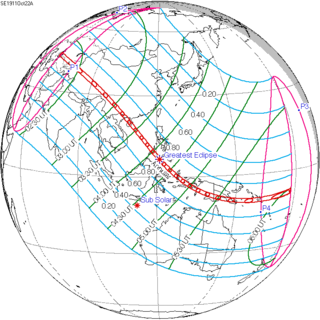
An annular solar eclipse occurred at the Moon's descending node of orbit on Sunday, October 22, 1911, with a magnitude of 0.965. A solar eclipse occurs when the Moon passes between Earth and the Sun, thereby totally or partly obscuring the image of the Sun for a viewer on Earth. An annular solar eclipse occurs when the Moon's apparent diameter is smaller than the Sun's, blocking most of the Sun's light and causing the Sun to look like an annulus (ring). An annular eclipse appears as a partial eclipse over a region of the Earth thousands of kilometres wide. Annularity was visible from the Russian Empire, China, French Indochina, Philippines, Dutch East Indies, Territory of Papua including the capital city Port Moresby, and British Western Pacific Territories.
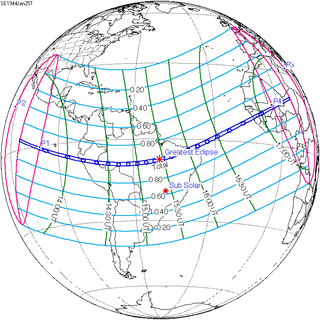
A total solar eclipse occurred at the Moon's descending node of orbit on Tuesday, January 25, 1944, with a magnitude of 1.0428. A solar eclipse occurs when the Moon passes between Earth and the Sun, thereby totally or partly obscuring the image of the Sun for a viewer on Earth. A total solar eclipse occurs when the Moon's apparent diameter is larger than the Sun's, blocking all direct sunlight, turning day into darkness. Totality occurs in a narrow path across Earth's surface, with the partial solar eclipse visible over a surrounding region thousands of kilometres wide. Totality was visible from Peru, Brazil, British Sierra Leone, and French West Africa. At greatest eclipse, the Sun was 78 degrees above horizon.
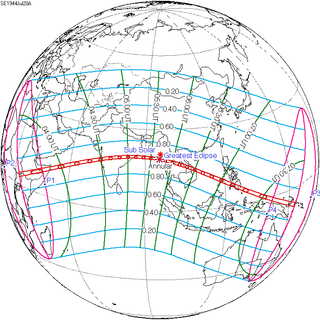
An annular solar eclipse occurred at the Moon's ascending node of orbit on Thursday, July 20, 1944, with a magnitude of 0.97. A solar eclipse occurs when the Moon passes between Earth and the Sun, thereby totally or partly obscuring the image of the Sun for a viewer on Earth. An annular solar eclipse occurs when the Moon's apparent diameter is smaller than the Sun's, blocking most of the Sun's light and causing the Sun to look like an annulus (ring). An annular eclipse appears as a partial eclipse over a region of the Earth thousands of kilometres wide. Annularity was visible from British Uganda, Anglo-Egyptian Sudan, British Kenya, Ethiopia, British Somaliland, British Raj, Burma, Thailand, French Indochina, Philippines, South Seas Mandate in Japan the Territory of New Guinea.
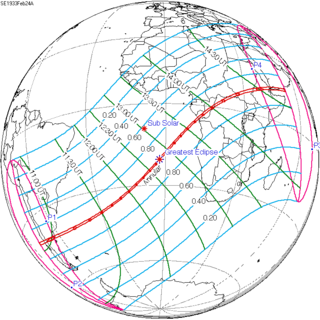
An annular solar eclipse occurred at the Moon's ascending node of orbit on Friday, February 24, 1933, with a magnitude of 0.9841. A solar eclipse occurs when the Moon passes between Earth and the Sun, thereby totally or partly obscuring the image of the Sun for a viewer on Earth. An annular solar eclipse occurs when the Moon's apparent diameter is smaller than the Sun's, blocking most of the Sun's light and causing the Sun to look like an annulus (ring). An annular eclipse appears as a partial eclipse over a region of the Earth thousands of kilometres wide. Annularity was visible from Chile, Argentina, Portuguese Angola, French Equatorial Africa, Belgian Congo, Anglo-Egyptian Sudan, Ethiopia, French Somaliland, southeastern Italian Eritrea, and Mutawakkilite Kingdom of Yemen, Aden Protectorate and Aden Province in British Raj.



























































































































